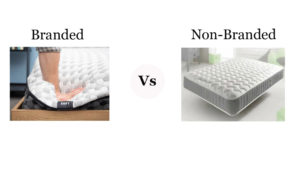Do you know that foams can be categorized according to their densities?
Do you have any idea how beneficial the high-density foams are?
If not, you are at the right place because we will introduce you to different aspects of this foam type. Starting from the benefits to the features of the high-density foam layer, we have discussed everything below to provide you with the clarification you need.
- Also Read: Best Foam Mattress in India 2023
Contents
1. What is high-density foam?
High-density foam has the fibres packed tightly to fit maximum mass within the given dimensions of the mattress. As a result, they are firmer and have the highest conforming rate as compared to other densities. In addition, the high-density foams are heavyweight, so it is used as a support layer for softer mattresses.
2. How is foam density measured?
To calculate the foam’s density, you need to know two things:
- The weight of the mattress is expressed as mass.
- You can calculate the total volume of the mattress by multiplying length, breadth, and thickness.
Once you have these values, divide the mass by mattress volume and get its density.
So the equation is, Foam Density = Mass/Mattress Volume
3. Difference between density and firmness
- Density is defined as mass per unit volume. It means how many foam fibres are packed in one cubic centimetre volume.
- On the other hand, firmness means how hard or soft the foam is. You cannot rate the overall firmness of the mattress based on the density of one particular material layer.
For example, if the HD foam has high density, the mattress may or may not have high firmness.
4. Benefits of high-density foam
- With a high-density foam, you will be able to get relief from the constant soreness and stiffness in your spine and the back muscles.
- It will also help maintain your spine’s structure and shape, thereby ensuring that your sleep posture is correct.
- Due to the high conform rate, the foam can apply the right amount of pressure on the tensed muscle knots.
- High-density foam is also more durable than other foam types, so its a low sagging rate.
5. How to decide whether you need a high foam density mattress or not?
- Durability: Without a doubt, the high-density foam is durable as compared to the soft and medium density foams. That’s one of the reasons why most mattress brands use this foam type for the support layer.
- Motion isolation: High-density foams can isolate the motion of your partner, and hence, your sleep won’t be disturbed even if your partner is moving a lot right beside you.
- Support: It has a high firmness level which is why the foam can support your spine structure and maintain its unique curvature. In addition, it also supports your body weight and makes sure that you won’t have to suffer from bone aches.
- Pain pressure relief: Due to the high conforming ability of the high-density foam, they can apply the right amount of pressure on the trigger points. As a result, your tensed muscle knots will easily open up and provide you with relaxation.
- Conforming: The confirming rate of the high-density foam is pretty high as it always stays close to the sleeper’s body without leaving any gap between the two surfaces.
- Temperature neutrality: The high-density foam has the fibres packed tightly, which restrict the airflow from within the mattress layer. This is why the foam type usually has a temperature equivalent to room temperature. Therefore, if the room is hot, the foam’s surface will feel hot and vice versa.
- Movement: High-density foams are quite stable, and they don’t usually move from their place, no matter how slippery the bed’s surface is on which you have placed the bedding material.
Conclusion
This article explains everything you need to know about a high-density foam, starting from explaining what it is to the features. Since now you have a better idea about this foam type, we are certain that you will choose the right mattress appropriate for your health.
FAQ’s
-
Can I sleep on high-density foam?
Yes, you can easily sleep on a high-density foam because it has a high firmness level which is good for your spine’s health and shape. In addition, such foams can maintain the posture of your body while you are sleeping in any way.
-
How long does high-density foam last?
High-density foam has higher durability as compared to other foam types having soft to medium density. It can last for several years, between the time range between 7 to 9 years. Moreover, the sagging rate is very low, so even after 5 years, the foam will have the same thickness.
-
How can you tell if the foam is high density?
A foam’s density can be explained by its firmness and conform level. So, for example, if the foam has a hard feeling with a weight more than the standard limit, you can label that particular foam’s density is as high.
-
How much does high-density foam compress?
The high-density mattresses do not compress too fast. Since the air pockets are minimal in number, you won’t have to worry about the foam being compressed to an extent where it cannot return to its original shape.
-
What is the difference between high density and medium-density foam?
The basic difference between a high density and medium density foam is in terms of firmness and conformity. High-density foam is quite firmer than medium density foam, so the former is used widely in manufacturing orthopaedic mattresses.


